Hello,
This is my first post. We've been trying to identify a suit of armour, can anyone help? This is just the helmet but shows the engraving that appears on the entire suit. I couldn't get a good shot of the suit it it's entirety so we took the helmet outside to get better lighting. When it was purchased we thought it was just a bit of costume armour but there are adjustments to the length of the legs and the detail seems much too good for just stage props. So we wondered if it was something more?
I will attempt to attach this photo again. My apologies for the difficulties.
 Attachment: 109.21 KB
Attachment: 109.21 KB


Welcome! It's a close helmet in the style of the late 16th or early 17th c.. It's likely not for theatrical use, as you note, but might be a better-quality decorative piece from the 19th or early 20th c. We'll see what the consensus is here. Some of those modern decorative antiques can be quite valuable, depending on the maker and quality.
A view or description of the inside of the helmet would give us a better idea of authenticity. There are some elements here that make me think it's modern, but some that would not be out of place on an original of this type. The break in the roped comb on the visor suggests a very thin steel there, which would not be desirable in a functional harness.
Compare to this piece at auction: http://www.hermann-historica.de/auktion/hhm59...at59_a.txt
Looks like a nice piece and I'm sure any of us would be happy to have it!
If you live near Leeds, the Royal Armouries folks would have a look at it for you. If near London, contact Tobias Capwell at The Wallace Collection.
A view or description of the inside of the helmet would give us a better idea of authenticity. There are some elements here that make me think it's modern, but some that would not be out of place on an original of this type. The break in the roped comb on the visor suggests a very thin steel there, which would not be desirable in a functional harness.
Compare to this piece at auction: http://www.hermann-historica.de/auktion/hhm59...at59_a.txt
Looks like a nice piece and I'm sure any of us would be happy to have it!
If you live near Leeds, the Royal Armouries folks would have a look at it for you. If near London, contact Tobias Capwell at The Wallace Collection.
Thank you Sean. The photos are quite helpful. It's late here now but I will try to have a closer look and post more detail from the inside of the helmet in the morning. I will also endeavour to take a full-length photo of the entire suit.
My knowledge of late16th/17th century armour is limited, but to me, that piece looks like a Victorian reproduction. Something about it just doesn't look quite right.The etching is well done, though.
A photo of the rest of the armour would be very helpful. If you can't photograph all of it at once, pictures of the individual components would be good.
A photo of the rest of the armour would be very helpful. If you can't photograph all of it at once, pictures of the individual components would be good.
| Jojo Zerach wrote: |
| The etching is well done, though. |
Very good etching is one of the ways to tell a victorian repro from an original. Victorian repros used a different method resulting in cleaner, deeper, and crisper etching.
[ Linked Image ]
This is a 19th century reproduction, you can see how deep and crisp the etching is.
[ Linked Image ]
the difference is clear when compared to an original.
Thank you for your insight and the photos. The etching on our suit is not so "deep" as in the Victorian Helmet shown. When you run your finger over it, you can feel the engraving but it appears smooth when you look at it. I've tried to take more photos but it's a dismal day here and not much detail can be seen on the full armour suit. Still, I have a few photos of just parts of the suit that came out okay which I will share. The second photo has two yellowish spots which are just reflections of the overhead light.
Here are some observations about the "Fred" as we call him:
My husband received the armour dismantled and very rusty in a cardboard box. Thinking it was just a theatrical costume he began cleaning it using sand paper and a wire brush in an electric drill.
As the cleaning ensued, he noticed the metal appeared very hard and would not scratch easily. The decoration is not exactly applied, but does not appear symetrical. A close look at the etching shows it is not very deep and is worn off in some places. There are a number of rivets in various parts of the armour that suggest they were there to fasten a lining of some sort. On the helmet, especially, these are well-finished to the point of almost being invisible. Some have fallen off over time.
The rivets vary, indicating repairs at different times, some being very crude with cut square washers on the inside, while others just have large, poorly finished heads.
The breast plate is especially thick, made up with a heavy metal lining.
A curious thing is that the tops of the leg guards appear to have been extended, as if the suit were adjusted as the owner grew. This also is evident in the shoulder guards, which seem to have been made larger.
The tall collars look as if they may have had some sort of decorative lining. The metal edge does not quite crimp around and the inner face appears unfinished, implying it was not supposed to be seen. All the inner surfaces of the suit also appear hammered and not smooth in the same way as the exterior.
I hope the notes help.
 Attachment: 69.42 KB
Attachment: 69.42 KB
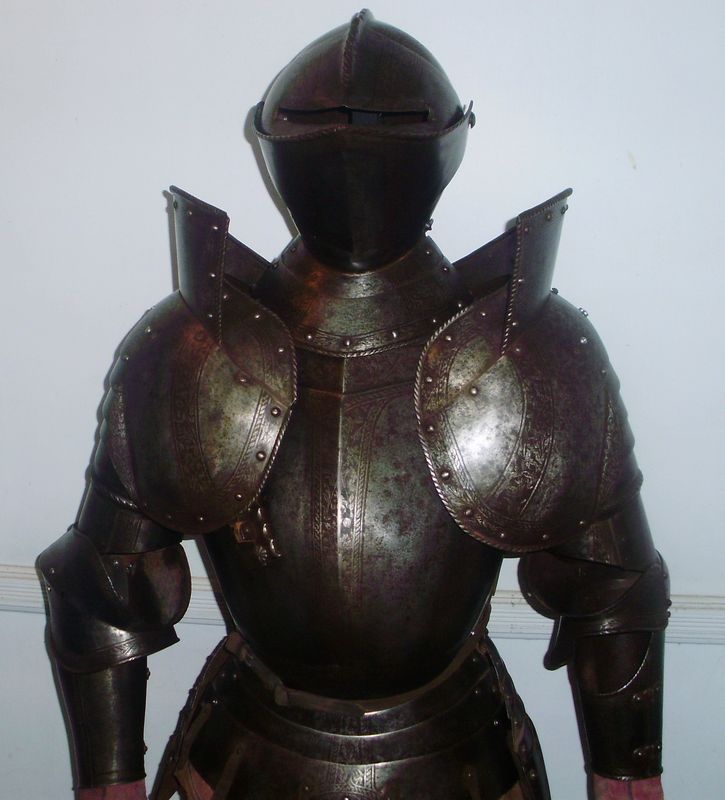
front upper torso view
 Attachment: 71.08 KB
Attachment: 71.08 KB
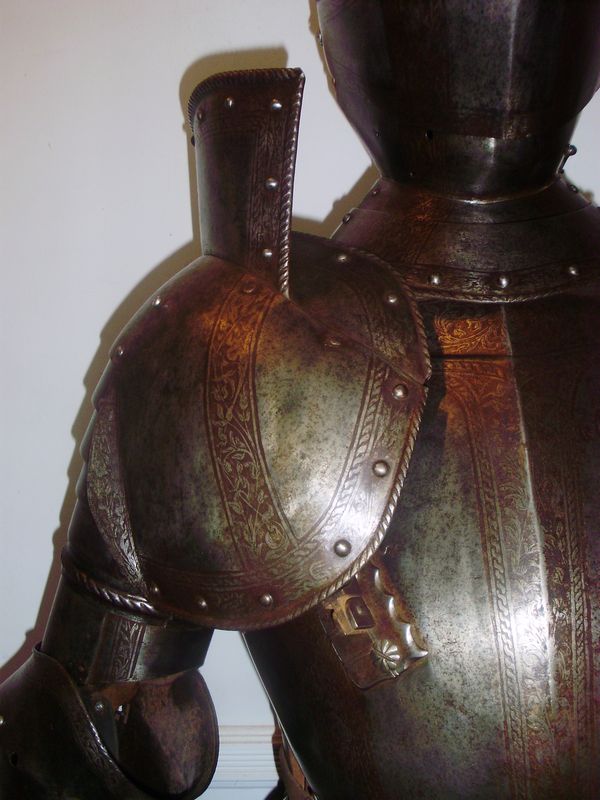
close up of breast plate and right shoulder
 Attachment: 71.63 KB
Attachment: 71.63 KB
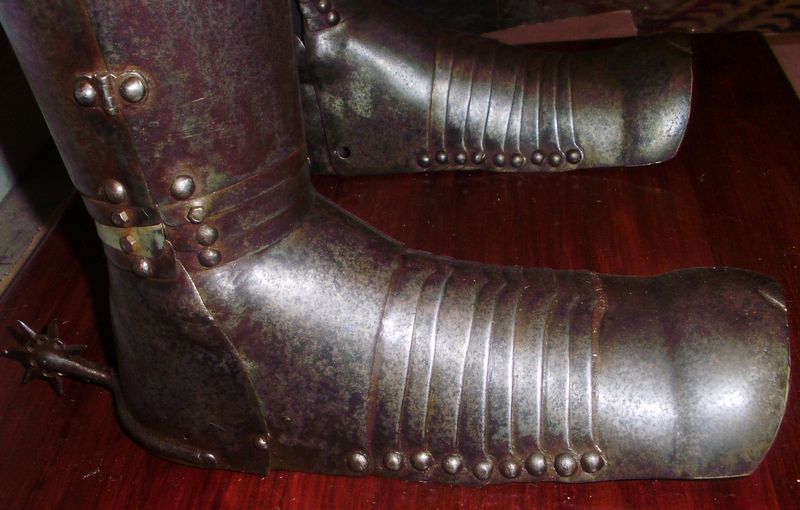
boots, some repair on ankle
Here are some observations about the "Fred" as we call him:
My husband received the armour dismantled and very rusty in a cardboard box. Thinking it was just a theatrical costume he began cleaning it using sand paper and a wire brush in an electric drill.
As the cleaning ensued, he noticed the metal appeared very hard and would not scratch easily. The decoration is not exactly applied, but does not appear symetrical. A close look at the etching shows it is not very deep and is worn off in some places. There are a number of rivets in various parts of the armour that suggest they were there to fasten a lining of some sort. On the helmet, especially, these are well-finished to the point of almost being invisible. Some have fallen off over time.
The rivets vary, indicating repairs at different times, some being very crude with cut square washers on the inside, while others just have large, poorly finished heads.
The breast plate is especially thick, made up with a heavy metal lining.
A curious thing is that the tops of the leg guards appear to have been extended, as if the suit were adjusted as the owner grew. This also is evident in the shoulder guards, which seem to have been made larger.
The tall collars look as if they may have had some sort of decorative lining. The metal edge does not quite crimp around and the inner face appears unfinished, implying it was not supposed to be seen. All the inner surfaces of the suit also appear hammered and not smooth in the same way as the exterior.
I hope the notes help.

front upper torso view

close up of breast plate and right shoulder

boots, some repair on ankle
Wow! I'd guess that at minimum you have a very nice 19th c. harness. Might even be a composite, with some original elements. The helmet still doesn't look quite right to me for some reason. I really think it's worth taking the helmet and breast to Leeds or London for help, or at least sending them some good photos.
The etching, and the way you describe the rivets seems authentic, but the general neck area looks a bit strange to me, and the lower legs (greaves) look to flat.
(Are the these actually shaped like a lower leg, or are they a tapered tube all the way through?)
(Are the these actually shaped like a lower leg, or are they a tapered tube all the way through?)
| Anna M B wrote: |
| Thinking it was just a theatrical costume he began cleaning it using sand paper and a wire brush in an electric drill. |
please tell him to stop this. I'm by no means an expert on armor restoration (hopefully someone who is can chime in) but from my admittedly limited knowledge I'm fairly certain both of those are mistakes and can cause damage to the armor and a loss in value. Lots of people damage their antiques with well-meaning, but incorrect and often over-zealous, cleaning. From what I can see this looks like a valuable antique piece, even if its a victorian repro and not an authentic. You definitely need to take this to a professional to have it appraised and perhaps properly restored.
Seeing more of it I'm reminded of one of Henry II's armors from the middle of the 16th century, especially the large single ocularium of the visor which I haven't seen on many extant helmets from the period. In general though the lines and style of the harnesses are pretty similar. .
http://www.metmuseum.org/toah/works-of-art/39.121
One of the things that bothers me is the small, thin comb. My guess would be that its a 19th century reproduction of this style harness, but I'm FAR from an expert so once again I think you definitely should show it to a professional because parts of it, if not the whole thing, could be much older. As Sean Flynt suggested showing it to a specialist at a museum would probably be your best bet.
Don't worry, all vigorous cleaning was stopped the moment the design appeared as we reasoned it was useless in a stage costume since the audience would likely not see it.
As to the legs, they are shaped, one looking slightly larger than the other. There is a piece of the armour missing in the front. Something that attaches at the lower waist. There are straps there but these are not authentic. In the back there are a series of "slats" that make up the part below the waist.
I have been trying to take a few more photos but it's another dull day and the detail is lost. Once I get something worth looking at I will post it.
When looking at the full suit, the head seems a bit small, and it's possible there have been changes to it. The legs have been altered to make them longer, and we believe the shoulders may have had some alteration for size as well.
There was a show on here a few weeks ago that showed how armour was made and that is what got us thinking we ought to find out more about "Fred." We will try to get a professional to have a look at him. I think that is probably the best thing to do.
Thank you all for your kind advice. I will post more photos when I have better lighting!
As to the legs, they are shaped, one looking slightly larger than the other. There is a piece of the armour missing in the front. Something that attaches at the lower waist. There are straps there but these are not authentic. In the back there are a series of "slats" that make up the part below the waist.
I have been trying to take a few more photos but it's another dull day and the detail is lost. Once I get something worth looking at I will post it.
When looking at the full suit, the head seems a bit small, and it's possible there have been changes to it. The legs have been altered to make them longer, and we believe the shoulders may have had some alteration for size as well.
There was a show on here a few weeks ago that showed how armour was made and that is what got us thinking we ought to find out more about "Fred." We will try to get a professional to have a look at him. I think that is probably the best thing to do.
Thank you all for your kind advice. I will post more photos when I have better lighting!
The more I hear about this, the more it sounds like a composite of original plates and modern repairs and replacements. This is common even in museum displays. Bits and pieces come to collectors and they assemble them and commission new parts (or scrounge antique reproductions) to match--something as small as a washer or as large as a helmet.
I see a touch of old red velvet at the wrists. Did this harness come complete with an old display? If so, I think that adds weight to the composite theory.
I see a touch of old red velvet at the wrists. Did this harness come complete with an old display? If so, I think that adds weight to the composite theory.
Have to admit, was very alarmed at the mention of sandpaper and wire brush. Agree with Sean on this piece. Been waiting a few days to see if anyone had noticed ... the arms appear to be on backwards; the shape of the pauldrons/haute pieces and elbow cops are more than a clue. What might appear to be an extension in the upper leg may be articulation for that area. Hope to see more photos, maybe one showing full length.
Cheers,
Dan
Cheers,
Dan
When we got the suit, it was just in a cardboard box; a bunch of rusted parts. Once the separate pieces were cleaned my husband fashioned a stand for the suit. The trousers, leather jerkin and gloves were added just to pad it out a bit, they didn't come with the armour. My husband did think he had put the arms on the wrong way around, after we'd lived with it for a little while but we weren't 100% sure.
I'm attaching two photos, one of the lower legs so you can see the shape, and another showing the part added at the top of the leg to lengthen it. This is solid and does not move, so I don't think it could be for articulation. The full length photos I take still come out too dark and look more like the Black Knight than Fred. We've moved the suit around trying to get better lighting but will probably have to wait for the sun to get a decent full-length shot.
 Attachment: 45.25 KB
Attachment: 45.25 KB
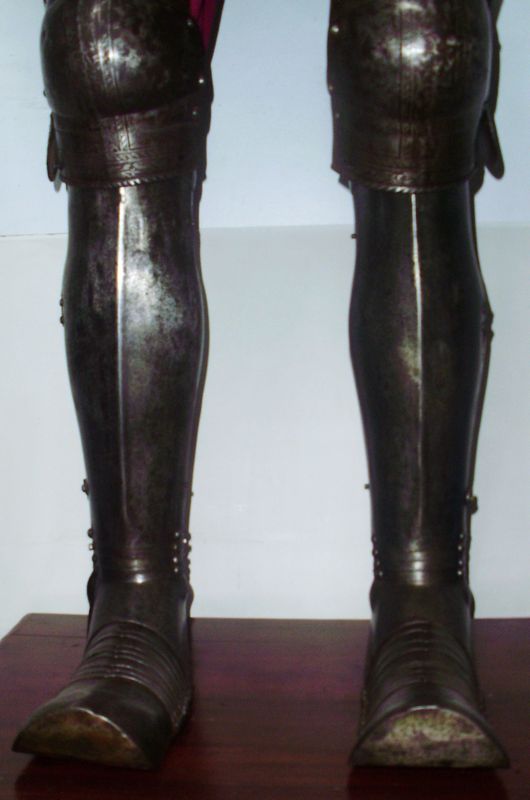
 Attachment: 74.72 KB
Attachment: 74.72 KB
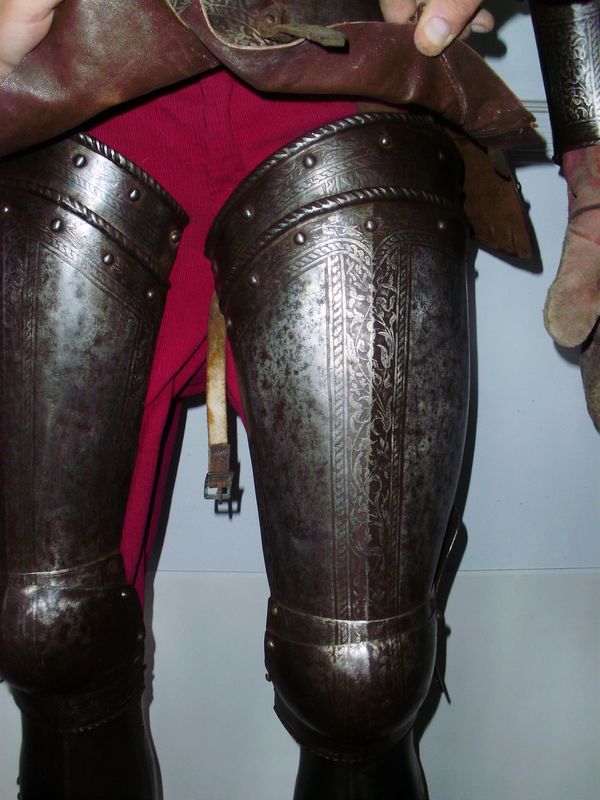
I'm attaching two photos, one of the lower legs so you can see the shape, and another showing the part added at the top of the leg to lengthen it. This is solid and does not move, so I don't think it could be for articulation. The full length photos I take still come out too dark and look more like the Black Knight than Fred. We've moved the suit around trying to get better lighting but will probably have to wait for the sun to get a decent full-length shot.


Oh, okay, it was just the bottom part of the greaves that were tubular.
After seeing the legs, I also agree that this could be a composite piece, with possible Victorian additions/modifications. What looks like extensions on the upper legs could simply be the way it was constructed originally. That extra piece might have articulated originally, but has since been riveted solid.
The lower legs also don't really match up with the upper legs, (either stylistically or proportionally) so the lower legs were probably originally a separate piece. (possibly a Victorian reproduction.)
For comparison, here is another, similar upper leg piece, dated to about 1580.
http://www.allenantiques.com/images/CzernysLeg2010.jpg
After seeing the legs, I also agree that this could be a composite piece, with possible Victorian additions/modifications. What looks like extensions on the upper legs could simply be the way it was constructed originally. That extra piece might have articulated originally, but has since been riveted solid.
The lower legs also don't really match up with the upper legs, (either stylistically or proportionally) so the lower legs were probably originally a separate piece. (possibly a Victorian reproduction.)
For comparison, here is another, similar upper leg piece, dated to about 1580.
http://www.allenantiques.com/images/CzernysLeg2010.jpg
| Daniel Sullivan wrote: |
| the arms appear to be on backwards; the shape of the pauldrons/haute pieces and elbow cops are more than a clue. |
wow, I was really bothered by those two things, but for some reason it never occurred to me they had just put them on backwards. I just thought that they were Victorian parts that had been made incorrectly. I guess I've never actually seen a harness with them on backwards before. Now I feel dumb because its really obvioius!
When you have a professional look at it be sure to let us know the results, I'm interested to see what parts are authentic, if any, and what has been replaced in later periods. I'm almost certain the helmet is not authentic but the legs seem to be.
what made me think that the pauldrones were odd was that the lance rest, was clearly on the breastplate yet clearly the pauldron blocks the armpit opening.
We need a good profile photo of the helm. It does look a bit microcephalic. The upper bevor, the comb, and the broad, undivided occulariam are what are bothering people. The occularium is very French, but a bit wide. The upper bevor just doesn't look real; shape is wrong, doesn't fit right, and no cut-out for the visor lift. The roping on it is of much poorer quality than the gorget lame, near as I can tell. It is not at all uncommon for most of a helm to have a restored visor or upper bevor. The comb doesn't bother me that much, as some styles are like that. It is of great interest that the cuisses do not go with the greave/sabatons, which are nice Victorian work, except for the toecaps, which they often just biffed. :wtf: Maybe the greaves are authentic, but I doubt it. It does make me think a closer look at those cuisses is in order. The cuirass sounds very good, and it would be nice to see a good photo of its inner surface. The description of the internal surfaces being all hammered-up and the hard metal sounds at the very least like a lot of old metal was used to make Fred. And let's do see what the arms look like right way round!
Last edited by James Arlen Gillaspie on Sat 09 Jun, 2012 11:48 am; edited 1 time in total
P.S. the top of the breastplate is a little strange, and it would be nice to see it without the helm on top.
Duh! Boy, are my wits sleepy! :blush: The ankle lames are overlapping the wrong way!
 Attachment: 27.62 KB
Attachment: 27.62 KB
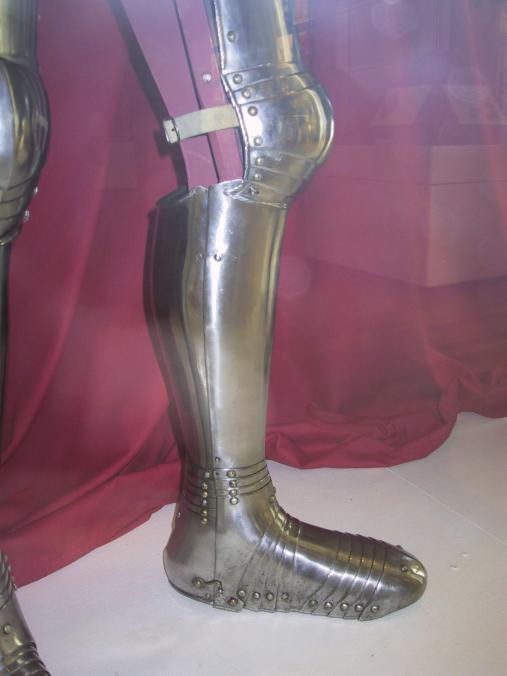

Page 1 of 2
You cannot post new topics in this forumYou cannot reply to topics in this forum
You cannot edit your posts in this forum
You cannot delete your posts in this forum
You cannot vote in polls in this forum
You cannot attach files in this forum
You can download files in this forum
All contents © Copyright 2003-2006 myArmoury.com — All rights reserved
Discussion forums powered by phpBB © The phpBB Group
Switch to the Full-featured Version of the forum
Discussion forums powered by phpBB © The phpBB Group
Switch to the Full-featured Version of the forum